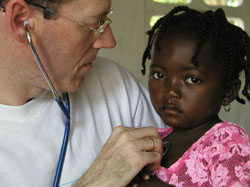| |
 |
|
|
|
|
| |
Harvard Medical School's Dr. Paul Farmer will discuss community-based care from Haiti to Rwanda in the Apr. 26 Hill Memorial Lecture. |
|
Social forces shape not only disease burden but also access to diagnosis and effective health care. Inequalities of access worsen, in turn, the burden of disease in many parts of the world. HIV/AIDS has crystallized these inequalities and poses substantial challenges to health systems
worldwide.
Addressing inequalities in health-care access is the mission of Partners In Health, whose cofounder, Dr. Paul Farmer, will talk about "Community-based Care for Chronic Infectious
Disease: The Partners In Health Experience
from Haiti to Rwanda" in this year's NIAID James C. Hill Memorial Lecture on Thursday, Apr. 26 at 2 p.m. in Lipsett Amphitheater,
Bldg. 10.
Farmer is the Maude and Lillian Presley professor
of medical anthropology in the department of social medicine at Harvard Medical School and associate chief of the division of social medicine and health inequalities at Brigham and Women's Hospital, Boston.
The Hill lecture is dedicated to the memory of the former NIAID deputy director who helped build the institute's HIV/AIDS research program
during the early years of the epidemic. A reception outside of Lipsett Amphitheater will be held after the talk.
In advance of his lecture, Farmer discussed several
issues:
How do you combine the perspective of a physician, focusing on the individual patient, with that of an anthropologist, looking at how cultural and social forces influence whole populations?
"Clinical and population-based approaches can and should be complementary; the idea that they are at odds with each other has created
a false dichotomy. In the AIDS epidemic, this dichotomy has played out as a struggle between experts and activists over whether scarce resources should be spent on prevention or care. Our experience in Haiti suggests the two can be mutually
reinforcing.
"When we introduced free voluntary HIV testing and counseling in rural Haiti in 1986, we knew it was going to be central to prevention. Yet when we were building
the women's health center there in 1990, we discovered that only a third of all women receiving prenatal care opted for a free HIV test when it was offered to them. In those days, effective therapy for AIDS was unavailable. But after we began offering three-drug regimens for people with HIV, the rate of women taking
the test jumped to more than 95 percent and now it routinely stands at close to 100 percent. The same thing happened in Rwanda.
"Obviously we have not eradicated poverty or inequality or changed the forces that engender and sustain them, but we have reinvigorated primary health care in settings long bereft of even basic health services. Simply by doing a good job as doctors and health workers, we have strengthened prevention efforts and integrated treatment for this one disease into a broad public health approach that seeks to address all diseases of poverty."
What lessons from your work in impoverished rural areas are applicable in the United States?
"The lack of community-based health care is a grave problem in many parts of the United States. Chronic diseases are still largely managed by doctors in their offices, which may be hard for people to reach. People are largely expected to make their own way to their appointments, which may occur only once every few months. They are given prescriptions and advice, but there may be no follow-
up after that to make sure they are obtaining and adhering to their drug regimens.
Home visits are long out of fashion.
"This model of care isn't very effective for AIDS, diabetes or other chronic diseases.
And the more people's lives are affected by social problems in this country, the less effective this system becomes.
"Community health-care workers are really the best way to address this problem, as we have shown in Haiti and later in Peru, Boston and Rwanda. People sometimes
misunderstand this to mean that community health-care workers should fill the gap in areas that lack enough doctors and nurses. What we are saying is even if there are doctors and nurses aplenty, community health workers are still a major asset.
"In our practice in Boston, we are training community health workers to visit patients in their own neighborhoods. The patients I see in a U.S. teaching hospital
have benefited enormously from such supervised community care."
How is the increasing influx of private foundation funds changing health care in impoverished rural areas?
"The real story is that things are a lot better now. There has been a major influx of money into international health-care initiatives-from private foundations, U.S. government programs and grants, from the Global Fund to Fight AIDS, Tuberculosis and Malaria and other sources. This is enabling us to do things we couldn't have attempted a few years ago. In Rwanda, we went into an abandoned hospital and rebuilt it. In an area with more than 400,000 people, there wasn't a single doctor. Now there are lots of doctors, lots of nurses.and hundreds of health-care workers. That really got rolling with private foundation money, including the Clinton Foundation, and within the public-sector institutions.
"Everybody can gripe about the structure and funding of different programs, but the fact is, it's great to finally be able to argue about how best to spend the money
when 5 years ago, the argument was, 'How can we get any resources at all?' Or worse, 'Is it even worth trying to do?'"